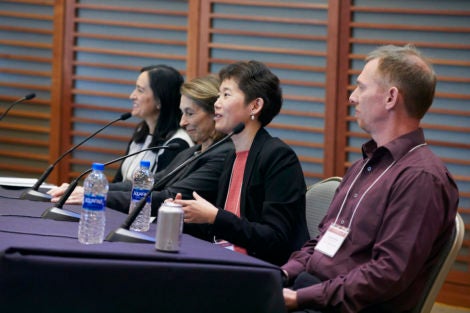November 20, 2019—In recent years, researchers have been making progress on developing treatments that leverage the human immune system to overcome various forms of cancer. The relatively nascent pursuit of cancer immunotherapies holds great promise, but before that promise can be realized scientists must untangle how the immune system—an incredibly complex network of specialized cells and proteins—operates at the most basic level. That requires conducting studies that generate massive amounts of data on everything from the microbiome to the human genome—and developing statistical and analytical methods to make sense of the data.
Earlier this month, the Program in Quantitative Genomics at Harvard T.H. Chan School of Public Health gathered together experts from around the world to share their research and exchange ideas on how best to decipher these complicated data sets. The conference, “Quantitative Challenges in Cancer Immunology and Immunotherapy,” drew some 150 attendees to the Joseph B. Martin Center.
“The field of cancer immunology and immunotherapy is facing quantitative and computational challenges,” said conference chair Shirley Liu, professor of biostatistics and computational biology at Harvard Chan School and co-director of Dana-Farber Cancer Institute’s Center for Functional Cancer Epigenetics. “That’s why it’s so important that this event brought together researchers from diverse backgrounds in machine learning, biostatistics, cancer genomics, and immuno-oncology.”

Researchers shared a broad range of research and insights over the course of the conference. Some of the studies were specific in scope, such as how melanoma responds to targeted treatments. Other events provided sweeping examinations of cancer immunotherapy research. During a panel discussion on the future of cancer immunology, Laurie Glimcher, president and CEO of the Dana-Farber Cancer Institute and Susan Smith Professor of Medicine at Harvard Medical School, discussed the importance of the academic enterprise in discovering new targets for cancer treatment and her concern that rising rates of obesity will soon make the disease the leading risk factor for cancer. She stressed that computational biologists are vital to making sense of the data being generated by health centers such as Dana-Farber.
After the conference, Liu said she was especially pleased that the event brought together seasoned scientists and ambitious junior researchers. “The interactions among pioneers in the field and newcomers who are eager to learn is vital,” she said. “Those are the interactions that will lead to better algorithms to examine the data with and, ultimately, novel discoveries in cancer immunology and immunotherapy.”
photo: Kent Dayton
